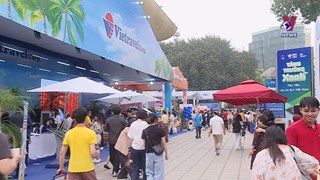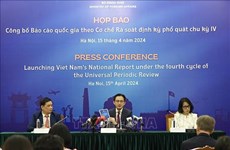EC decision to affect Vietnam’s seafood exports
Vietnam ’s seafood exports will certainly be influenced by the
strict requirements stated in the European Commission (EC)’s Regulation
1005, to take effect in January 2010, said a Vietnamese official.
Vietnam ’s seafood exports will certainly be influenced by the
strict requirements stated in the European Commission (EC)’s Regulation
1005, to take effect in January 2010, said a Vietnamese official.
Under the regulation, which covers establishing a system to prevent, deter and eliminate illegal, unreported and unregulated (IUU) fishing, each batch of seafood exported to the EU must be accompanied by a written commitment from the processing factory on the origin of products, or a catch certificate, said Nguyen Viet Manh, Deputy Director of the International Cooperation Department under the Ministry of Agriculture and Rural Development (MARD).
He added that these documents must be checked by authorised agencies in the importing countries before commodities are transported to their ports of entry.
The regulation specifies that the EU bans the import of illegally-caught seafood products. In cases where seafood exporters import materials from other countries, and include them in products for export, the same regulations on the certification and authorisation of such materials apply.
The EU also requires that catch certificates and commitments by processing factories must furnish details on fishing vessels, fishing zones, processing facilities, and export procedures, as well as the volume and types of seafood.
According to MARD Deputy Minister Luong Le Phuong, under international law, fishermen have the right to fish in their territorial waters. Therefore, it is difficult to give details on fishing zones and dates as well as to change the methods used by fishing communities to catch fish, he said.
Because Vietnam lacks supervision and certification systems and a large-scale fleet of vessels, with fishing operations dispersed over a wide area, it will face serious difficulties in ensuring IUU-compliance, managing fishermen, and providing them access to information on the application of the EC’s new regulation.
According to the Department of Production and Protection of Aquatic Resources, Vietnam now has around 130,000 fishing vessels, most of which are small-sized, and are expected to catch 2 million tonnes of aquatic products per year.
The MARD has established a working team which is responsible for implementing the requirements of EC Regulation 1005. However, a working team member said that it will be hard for them to meet all the requirements as the IUU will become effective within four months.
The EU is now Vietnam ’s largest seafood importer with 26 out of its 27 members importing products. In 2008, Vietnam ’s seafood volume shipped to the EU accounted for over 40 percent of its total seafood exports and 25.4 percent of its total export turnover.
Over the past years, Vietnamese businesses have always satisfied all standards set by the EU, a market with strict requirements on food quality and hygiene.
This was not only recorded by increasing volumes of seafood products to the EU over the years, but also reaffirmed by the recent EC approval of the inclusion of 30 more Vietnamese companies on its list of businesses entitled to export seafood to the EU, raising the total of Vietnam’s seafood businesses allowed to ship products to this market to 330./.
Under the regulation, which covers establishing a system to prevent, deter and eliminate illegal, unreported and unregulated (IUU) fishing, each batch of seafood exported to the EU must be accompanied by a written commitment from the processing factory on the origin of products, or a catch certificate, said Nguyen Viet Manh, Deputy Director of the International Cooperation Department under the Ministry of Agriculture and Rural Development (MARD).
He added that these documents must be checked by authorised agencies in the importing countries before commodities are transported to their ports of entry.
The regulation specifies that the EU bans the import of illegally-caught seafood products. In cases where seafood exporters import materials from other countries, and include them in products for export, the same regulations on the certification and authorisation of such materials apply.
The EU also requires that catch certificates and commitments by processing factories must furnish details on fishing vessels, fishing zones, processing facilities, and export procedures, as well as the volume and types of seafood.
According to MARD Deputy Minister Luong Le Phuong, under international law, fishermen have the right to fish in their territorial waters. Therefore, it is difficult to give details on fishing zones and dates as well as to change the methods used by fishing communities to catch fish, he said.
Because Vietnam lacks supervision and certification systems and a large-scale fleet of vessels, with fishing operations dispersed over a wide area, it will face serious difficulties in ensuring IUU-compliance, managing fishermen, and providing them access to information on the application of the EC’s new regulation.
According to the Department of Production and Protection of Aquatic Resources, Vietnam now has around 130,000 fishing vessels, most of which are small-sized, and are expected to catch 2 million tonnes of aquatic products per year.
The MARD has established a working team which is responsible for implementing the requirements of EC Regulation 1005. However, a working team member said that it will be hard for them to meet all the requirements as the IUU will become effective within four months.
The EU is now Vietnam ’s largest seafood importer with 26 out of its 27 members importing products. In 2008, Vietnam ’s seafood volume shipped to the EU accounted for over 40 percent of its total seafood exports and 25.4 percent of its total export turnover.
Over the past years, Vietnamese businesses have always satisfied all standards set by the EU, a market with strict requirements on food quality and hygiene.
This was not only recorded by increasing volumes of seafood products to the EU over the years, but also reaffirmed by the recent EC approval of the inclusion of 30 more Vietnamese companies on its list of businesses entitled to export seafood to the EU, raising the total of Vietnam’s seafood businesses allowed to ship products to this market to 330./.












